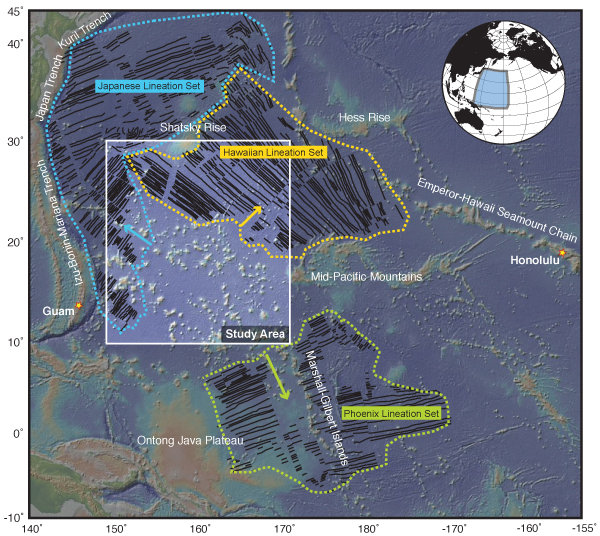Purpose of the Expedition
Marine magnetic anomalies have been mapped throughout the world's oceans, and they record the history of the Earth's magnetic field through geologic time. During the 180 million years of available seafloor, reversals in the polarity of the Earth's magnetic field appear to have been common except during two extended time periods, the Cretaceous Normal Superchron (84-124 Ma) and the Jurassic Quiet Zone (>157 Ma).
Magnetic surveys of the Cretaceous-aged seafloor indicate the presence of a strong, stable, and normally polarized planetary magnetic field that persisted for ~40 million years. In contrast, magnetic surveys from the Jurassic-aged seafloor have found only weak magnetic signatures with indistinct reversals that cannot be easily explained. On one hand, measurements of magnetic anomalies from slightly younger seafloor (155–160 million years ago) may suggest that the Earth's magnetic field was weak and had a rapidly changing direction of polarization during the Jurassic Quiet Zone. If true, this would indicate a unique time in Earth's past where the global geomagnetic field was particularly unstable, perhaps not even dipolar. On the other hand, the lack of observable polarity reversals in the Jurassic may be caused by the sheer age of the rocks and the myriad of local seafloor tectonics that they have undergone since their birth at the mid-ocean ridge.
What was the Earth's geomagnetic field doing during the Middle Jurassic? Was it behaving in a globally coherent way? Previous surveys measured the marine magnetic record in the Japanese Lineation set, a block of seafloor formed at one of the three Jurassic Pacific spreading centers. On this survey, we are measuring the marine magnetic record in the Hawaiian Lineation Set, which was formed at another Jurassic spreading center. If our magnetic measurements of the Hawaiian lineations can be correlated with the Japanese lineations, it will prove that the weak magnetic signatures of the Jurassic Quiet Zone were because of a globally weak, and perhaps unstable, magnetic field. On the other hand, if the magnetic surveys are unable to be correlated, we will still have obtained important information about the history of Earth’s geomagnetic field.
More Information
Tominaga et al. (2008), Deep-tow magnetic anomaly study of the Pacific Jurassic Quiet Zone and implications for the geomagnetic polarity reversal timescale and geomagnetic field behavior, Journal of Geophysical Research, Vol. 113, No. B07110, doi:10.1029/2007JB005527.
Tivey et al. (2006), Origin of the Pacific Jurassic quiet zone, Geology, Vol. 34, No. 9, p. 789–792.
Sager et al. (1998), Geomagnetic polarity reversal model of deep-tow profiles from the Pacific Jurassic Quiet Zone, Journal of Geophysical Research, Vol. 103, No. B3, p. 5269-5286.


